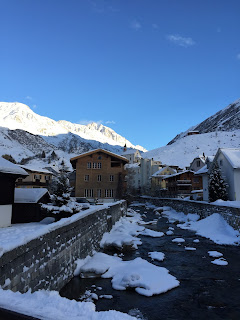Spent a few days in Capri, off the Sorrento coast in southern Italy in a lovely vacation home just
above the large port, the Marina Grande,
which provided relaxing views of all the port activity. Watched the fishermen leaving port in the
early morning and late afternoon, the ferry boats filled with day-trippers and
cars loading and unloading, and the ships bringing supplies to the inhabitants.
The first day we arranged for a tour around the island in a
small motorized, refurbished
fishing boat, with a cooler of beer and bottles of water, and towels for the
bathers. Of course the high point of the
boat tour was a visit into the world-famous Blue Grotto, the Grotto Azzurra. Many small boats filled with people crowded the water near the entrance to the
Grotto, where men on a larger boat collected entrance fees. We were then transferred
to an even smaller boat, with a guide. The Blue Grotto entrance is so small and
low (inaccessible at high tide) that the guide told us all to lie down in the bottom
of the boat, and he pulled the boat into the cave entrance using a metal
chain. Once inside the dark cave, the
glow of the aquamarine-blue water was just breathtaking -- my photographs
hardly do justice to the colors!
Continuing on the circuit of the Island of Capri, we passed
underneath a “Pharos” – a lighthouse whose light could be seen for 25 km.,
numerous caves, and the small harbor called the Marina Piccola.
Rounding a promontory, we came upon the equally
famous rock formation called the “Faraglioni”
a grouping of three huge limestone crags poking out of the sea, one of which
had an arched portal that our boatman guided us through, while we were snapping
many photos.
The next day we took the Funicular up to Capri Town and
walked the trail to visit the ancient ruins of the palace of the Roman Emperor
Tiberius, called the Villa Jovis,
which dates from the first century AD. Originally built by Emperor Augustus as
a vacation home, Tiberius reportedly was so worried about assassination that he
retreated to Capri, leaving Sejanus, his general of the Pretorian Guards, to
rule in Rome.
Today the remains of the palatial complex with numerous rooms,
apartments, staircases, and stables gives only a faint idea of how this
structure may have looked in 30 AD, but the vistas over the sea were spectacular.
While wandering around, I came upon three
goats, who apparently belonged to one of the caretakers, and the aroma they
gave off reminded me of Chèvre cheese (which comes from goats). The chance to
touch a bit of Imperial Roman history was well worth the hour hike up to the Villa Jovis.














































